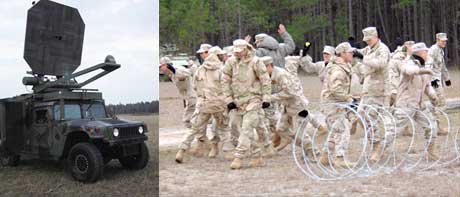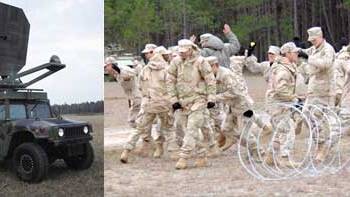Safety fears as US demonstrates crowd control heat-ray weapon
Source: guardian.co.uk

820th SFG evaluates non-lethal weapon - Moody Airmen test new, nonlethal method of repelling enemy
The 820th Security Forces Group is currently evaluating the Active Denial System, a non-lethal weapon designed to engage and repel human targets by projecting a beam of energy that creates an intolerable heating sensation on the skin. ADS can potentially give deployed Airmen another option to employ in the Global War on Terrorism. (U.S. Air Force photo by Airman 1st Class Gina Chiaverotti)
Images from: moody.af.mil
How the wave device works
It looks like a table top stuck on a Humvee, but to the US military it is a revolutionary new weapon, a controversial heat-ray destined to change the face of conflict by dispersing mobs, protecting military bases and sorting friend from foe without inflicting injuries.
Called Silent Guardian, the prototype fires a high-intensity beam of millimetre waves, inflicting a burning sensation like a light bulb pressed against the skin. After 12 years in development it has been demonstrated in public for the first time, at Moody air force base in Georgia.
For the US defence department it marks the beginning of an era of "non-lethal, directed energy, counter-personnel" weapons, intended to cause temporary pain instead of killing or maiming. But critics yesterday raised fears that the weapon could cause serious, even life-threatening burns through accident or misuse.
During the demonstration a two-man crew used built-in rangefinders to target volunteers playing the part of angry rioters 500 metres away. Those hit by the beam jumped out of the way immediately to escape the sudden flash of heat.
The beam has a range of up to 1km, 10 times that of other non-lethal weapons such as plastic bullets or beanbag-firing guns. The waves penetrate clothing, but travel less than half a millimetre into the skin, where they cause water molecules to heat up. Within seconds, the beam heats the skin to around 50C (122F). Military officials plan to use the so-called Active Denial System to keep would-be attackers from approaching military installations or navy ships in dock, or for repelling mobs. It may also be useful in sorting combatants from bystanders, who are more likely to quickly leave the scene.
Speaking from the Pentagon yesterday, Lieutenant-Colonel Brian Maka said the device, which is not expected to be ready for deployment until 2010, was built to "stop, deter and turn back an adversary at a distance that lessens the potential for causing injury".
But Neil Davison, an expert in non-lethal weapons at the Disarmament Research Centre, Bradford, said that in tests so far volunteers had been allowed a cooling off period after being hit before being targeted again. "There's no way of guaranteeing people won't be targeted for longer in a real situation," he said.
Jürgen Altmann, an expert in military technology at Dortmund University, found that if the beam is tracked on a person for longer the skin temperature can quickly rise above 55C, and begin to burn.
"Even if they build in a mechanism that limits it to work for only a few seconds at a time, people can immediately be re-targeted," he said. "If more than 20% of their body receives second or third degree burns, it's potentially life-threatening."
According to papers released under freedom of information requests, mishaps during trials have caused blistering at least six times and one second degree burn when the beam was fired on too high a setting. According to the US military, the risk of injury is less than 0.1%.
Also see: 820th SFG evaluates non-lethal weapon
Article from: http://www.guardian.co.uk/usa/story/0,,1999141,00.html






















